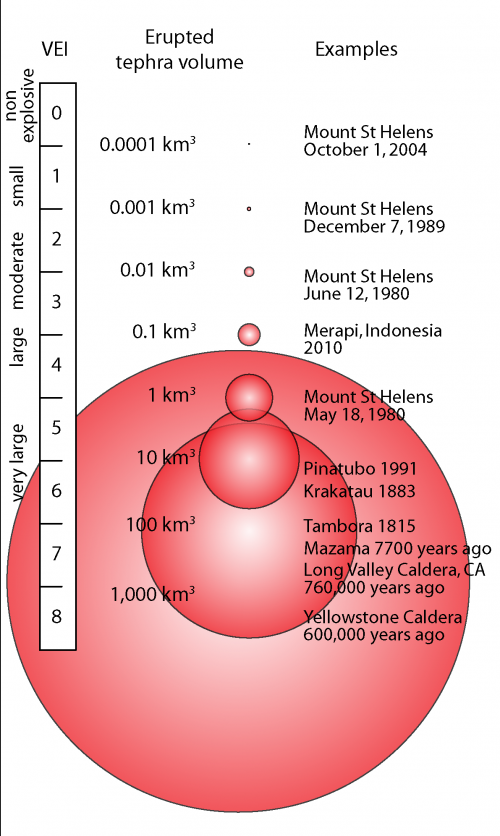Volcanic Explosivity Index (VEI)
The Volcanic Explosivity Index (VEI) is a relative measure of the explosiveness of volcanic eruptions. It was devised by Chris Newhall of the United States Geological Survey and Stephen Self at the University of Hawaii in 1982.Volume of products, eruption cloud height, and qualitative observations (using terms ranging from "gentle" to "mega-colossal") are used to determine the explosivity value. The scale is open-ended with the largest volcanoes in history given magnitude 8. A value of 0 is given for non-explosive eruptions, defined as less than 10,000 m3 (350,000 cu ft) of tephra ejected; and 8 representing a mega-colossal explosive eruption that can eject 1.0×1012 m3 (240 cubic miles) of tephra and have a cloud column height of over 20 km (12 mi).

About 40 eruptions of VEI 8 magnitude within the last 132 million years (Mya) have been identified, of which 30 occurred in the past 36 Mya. Considering the estimated frequency is > 50,000 years, there are likely many such eruptions in the last 132 Mya that are not yet known. Based on incomplete statistics, other authors assume that at least 60 VEI 8 eruptions have been identified. The most recent is Lake Taupo's Oruanui eruption, 25,360 years ago, which means that there have not been any Holocene eruptions with a VEI of 8. There have been at least 10 eruptions of VEI 7 in the last 10,000 years. There are also 58 plinian eruptions, and 13 caldera-forming eruptions, of large, but unknown magnitudes. By 2010, the Global Volcanism Program of the Smithsonian Institution had catalogued the assignment of a VEI for 7,742 volcanic eruptions that occurred during the Holocene (the last 11,700 years) which account for about 75% of the total known eruptions during the Holocene. Of these 7,742 eruptions, about 49% have a VEI of ≤ 2, and 90% have a VEI ≤ 3.
Volcanoes 2018 ©